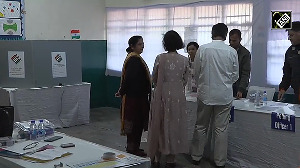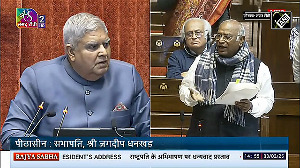There has been a spate of 'investigative' reports and analyses in the Indian media of late, which have all taken Indian defence research efforts to task, with special focus on the Indian government funded nodal agency, the Defence Research and Development Organisation.
The criticisms range from the mundane to the mind-boggling with the common ones being: The DRDO is a white elephant that does not produce enough output justifying its 'bloated' budget.
- Most big projects undertaken by the DRDO to date, such as the Arjun tank, the Light Combat Aircraft etc. have been 'failures.'
- The Indian armed forces still have to shop for weapons abroad despite decades of multi-crore government investments in DRDO.
These allegations, some of which have become ingrained in Indian media circles over the years, are now almost accepted as fact by almost every person who wishes to criticise the Indian defence industry.
But how much of this is true?
To find that out, one must establish some quantifiable benchmarks and compare the DRDO's performance with that of the R&D establishments of China, Pakistan and even Western nations.
First, DRDO's total annual budget, in terms of US dollars is around $800 million. That may seem to be a lot, but compare that to China's, which is conservatively estimated to be at 15% of its defence budget or close to $10 billion.
Another point of comparison is with India's major defence deals, which usually run into the multi billion-dollar range. Even at the 30,000 feet level, one can point out that it is naïve to expect an investment of $800 million to yield results worth many times more.
Second, what are the usual objectives for any developing world power when it comes to its native military industry? Most experts would say that the goals for a nation's Defence R&D efforts include:
Note that we are not talking about self-sufficiency, which is more of a function of the manufacturing of military products and meeting the services' quantity requirements. In India, they are mainly the responsibilities of the various Defence Public Sector Undertakings such as Bharat Dynamics Limited, Hindustan Aeronautics Limited etc.
In terms of the above criteria, where exactly does DRDO stand?
When it comes to strategic forces, one needs to look no further than the Integrated Guided Missile Development Program (IGMDP) which was initiated in 1983 under DRDO's auspices. While DRDO took care of the R&D, BDL was created for the production of developed products.
In the strategic arena, IGMDP has successfully developed the Prithvi series of short-range ballistic missiles and the Agni series of intermediate-range ballistic missiles, both of which are nuclear capable and in serial production.
The reader may wonder why there are regular tests of these missiles, if they are all ready to use. This is because once a particular system is developed, DRDO has to work with its end user, be it the Army, Navy or the Air Force to fine tune it to meet the user's requirements.
The Prithvi is among the most modern short-range battlefield missiles in the world. It has the highest warhead-weight to overall-weight of any missile in its class, a testament to the ingenuity of the designers.
Prithvi-I is the army variant, last tested in 1994 and currently deployed by the 333rd missile regiment. Prithvi-II is the Air Force variant, last tested in 2003 and currently with the IAF. Prithvi-III is a submarine fired variant, just tested successfully. Dhanush is a surface ship-launched variant, also tested successfully.
The Agni series of missiles have two successful versions in the armed forces inventory today. Agni-II, which confusingly was the first one to be produced, can carry a 1 tonne nuclear warhead to ranges over 2,000 km. Agni-I, which is a Pakistan specific asset, can carry a 1 tonne nuclear warhead to a maximum of 1,200 km range. Both the missiles are rail capable and are equipped with accurate guidance and solid fuel systems ensuring a flight time fast enough for an assured retaliation or a second strike capability. Both are under induction by the armed forces.
Clearly, it is hard to make an argument that DRDO has not delivered on the nuclear/missile front. They did the job when no one else would.
Moving on to the defence systems that are expensive to procure from abroad, one needs to look at the full picture.
For the Army, the systems needed include Main Battle Tanks (MBTs), Artillery, and Radars etc. But so far, the Indian media has exclusively focused on DRDO's Arjun MBT project, which has been deemed a disaster because the Army has still not used it after 30 years and over Rs 300 crores of development cost.
The tank has been trashed in the Indian press through the oft-used 'anonymous' sources at Army HQ. It is said it is 'too heavy' and 'slow' and it's 'too expensive' etc. Other media experts trumpet excerpts from reports by Parliamentary defence committees and the Comptroller and Auditor General pointing out problems with the Arjun project.
One could write a book debunking these claims, but it would suffice to say that the Arjun tank, as it stands today, meets almost all the Army's General Staff Qualitative Requirements (GSQRs) which is what the designers go by.
But the Army changed the GSQRs repeatedly.
The original requirement was for a 40-ton tank armed with a 105mm gun, and DRDO had to start from scratch. Midway through this process, the Army changed its requirement to a 120mm gun armed heavier tank, capable of going toe-to-toe with the American Abrams tank, which Pakistan, was about to acquire from the United States in the 1980s.
Those were the benchmarks that the Arjun had to meet and the Arjun of today is more than a match for the Abrams and equivalent Western tanks in terms of armour, firepower, mobility and protection. DRDO also successfully test-fired the advanced Israeli LAHAT anti-tank missile, which has a much longer range. Pakistan still does not have missile-firing tanks, by the way.
Now, if the Arjun is not exactly what the armoured corps wanted, the blame goes equally to army officials who set the requirements along with DRDO. Can one place an order with Tata for a Sumo type vehicle, keep changing the specs and expect a vehicle with the Indica's size and cost?
While the Arjun's media trial continues, the project itself resulted in a number of successful spin-offs. For instance, the bulk of India's tank fleet comprises aging T-72 tanks, some 1,700 of which are in India's inventory. One successful upgrade effort includes the mating of the Arjun's turret with the T-72's chassis, christened the 'Karna.'
This includes the Arjun's IGMS, a state-of-the-art, homegrown fire control system, Laser Warning System, Nuclear/Biological/Chemical detection and filtration system, Land Navigation System and night vision gear. Under trials now, the Army has indicated that it could order 300 or more Karnas in the coming years.
DRDO's 125mm piercing-piercing tank round is also a direct spin-off from the Arjun MBT program. These rounds are meant for the T-72 tanks. Over 130,000 such rounds have been produced by the state-owned Ordnance Factory Board's (OFB) since 2001, saving the army over Rs 200 crores per year in foreign exchange.
Another Arjun spin-off is the 'Bhim' self-propelled gun, which mates an Arjun chassis with the lethal Denel T-6 turret from South Africa, making it a system that is unmatched in the region in terms of firepower, mobility and survivability. A Rs 2,000 crore deal for 100 such guns is reported to be signed soon.
Most dispassionate observers would agree that the above results are enough not to deem a Rs 300 crore R&D effort to build a tank from scratch a failure. And there are more Arjun spin-offs to come!
Kaushik Kapisthalam is a US-based South Asia analyst






 © 2025
© 2025